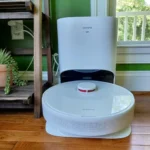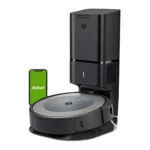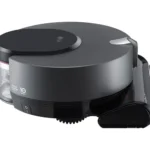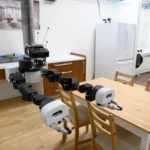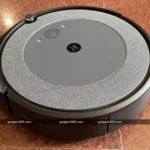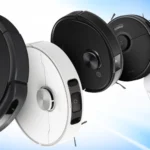Picture this: you come home to an immaculate house with no dust bunnies or debris on the floor. But, you are not the one who did all the cleaning, your smart vacuum cleaner did all the work for you. Smart vacuum cleaners have become increasingly popular due to their convenience and efficiency, but with so many options on the market, it can be difficult to determine which one is right for you. One common factor that many people consider when purchasing a smart vacuum cleaner is price. However, does a high price really guarantee better performance? In this article, we will explore the different types of smart vacuum cleaners, the features that affect their prices and performance, and the relationship between price and performance so that you can make an informed decision on buying a smart vacuum cleaner that truly fits your needs.
The Different Types of Smart Vacuum Cleaners
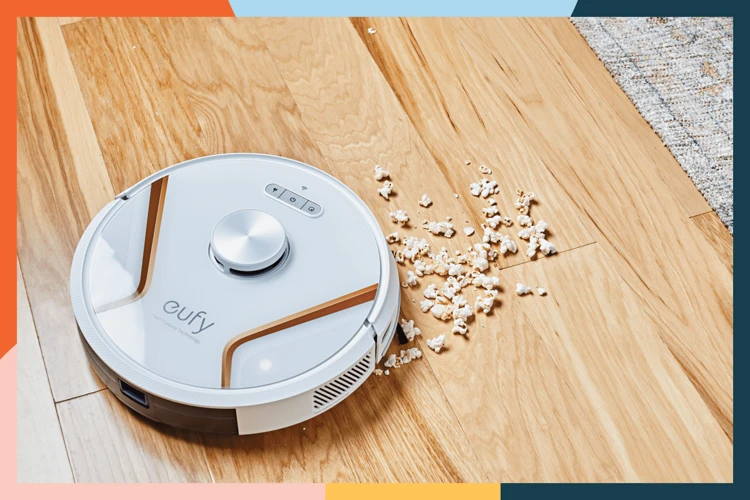
As you delve into the world of smart vacuum cleaners, you’ll quickly realize there are several types, each with its unique features and functions. From robot vacuum cleaners that do the work for you, to upright vacuum cleaners that provide powerful suction, the choices can be overwhelming. But don’t worry, we’ll break it down for you. In this section, we’ll explore the different types of smart vacuum cleaners, their pros and cons, and what makes them stand out. By the end, you’ll know which type of vacuum cleaner is right for you. So let’s get started!
Robot Vacuum Cleaners
Robot vacuum cleaners have become increasingly popular over the past few years, due to their convenience and efficiency. These devices are equipped with intelligent sensors and navigation systems that help them to move around obstacles and clean various surfaces without much human intervention.
Here are some key features of robot vacuum cleaners:
| Features | Description |
|---|---|
| Battery Life | Robot vacuum cleaners have rechargeable batteries that determine the runtime of each cleaning cycle. Longer battery life allows the device to clean a larger area without recharging. |
| Dustbin Capacity | The size of the dustbin determines how much debris the robot vacuum can pick up before requiring emptying. Larger bins mean more debris can be collected without the need for constant emptying. |
| Suction Power | Strong suction is essential for effective cleaning. Robot vacuum cleaners with high suction power can effectively pick up dust, debris, and pet hair from floors and carpets. |
| Navigation and Mapping | Robot vacuum cleaners use intelligent sensors and mapping technology to navigate around the room, avoiding obstacles and cleaning surfaces efficiently. |
| Multi-Surface Cleaning | The best robot vacuum cleaners can effectively clean various types of floors and surfaces, including carpets and hard floors. |
| Filtration System | Some robot vacuum cleaners come with high-quality filtration systems that can trap small particles and allergens, making them ideal for people with allergies or respiratory problems. |
It’s important to note that not all robot vacuum cleaners have the same features or performance capabilities. Some budget models may have limited battery life, lower suction power, and a smaller dustbin, resulting in less efficient cleaning. On the other hand, premium models often come equipped with advanced features that improve performance and overall cleaning quality.
Want to learn more about the factors that affect smart vacuum cleaner performance? Check out our article on factors that affect smart vacuum cleaner performance.
Ultimately, the cost of a robot vacuum cleaner will be influenced by the features, performance, and brand reputation. However, it’s important to remember that the most expensive device is not necessarily the best fit for every homeowner. Be sure to do your research before investing in a smart vacuum cleaner, to make sure it enhances your cleaning experience and provides the features you need.
Looking for recommendations on the best smart vacuum cleaner on the market? We’ve got you covered. Check out our article on the best smart vacuum cleaners.
Stick Vacuum Cleaners
Stick vacuum cleaners are slim and lightweight, making them perfect for maneuvering around tight spaces and hard-to-reach areas. They are ideal for those who live in small apartments or have limited storage space. Stick vacuum cleaners come in corded and cordless models, with the latter being more convenient as they are not limited by the length of the cord.
Features:
- Battery Life: Cordless stick vacuums depend on their battery life, so it is crucial to choose a model with a long battery life, or at least a removable battery that can be easily swapped for a fresh one. Models with advanced battery technology can run up to an hour or more on a single charge, while others can only last for a few minutes.
- Suction Power: Stick vacuum cleaners usually have less suction power compared to bulkier models. However, some high-end stick vacuums have powerful motors and advanced suction technology that can compete with the suction power of upright vacuums.
- Dustbin Capacity: Stick vacuums have smaller dustbin capacities compared to larger models, so they require more frequent emptying. Some models have a washable and reusable dustbin filter that eliminates the need for disposable vacuum bags.
- Multi-Surface Cleaning: Many stick vacuums are designed to perform well on both hard floors and low- to medium-pile carpets. Some models even have a motorized brush roll that helps pick up pet hair and debris.
The price of a stick vacuum cleaner is often determined by the model’s features and performance. As with other types of smart vacuum cleaners, the more advanced the features, the higher the price. However, it is important to note that a high price does not always guarantee high performance.
If you are in the market for a stick vacuum cleaner, it is important to do your research and consider your specific needs. A cheap model may save you money, but it may lack the features and performance necessary for deep cleaning. On the other hand, an expensive model may have all the latest features but may not fit your budget. Consider balancing features and pricing to make a wise choice.
To improve the performance of your smart vacuum cleaner, regardless of type, check out our article on the top features that affect smart vacuum cleaner performance. We also have tips for choosing a high-performance smart vacuum and improving the performance of your current smart vacuum cleaner.
Upright Vacuum Cleaners
When it comes to smart vacuum cleaners, upright vacuum cleaners are one of the most popular types. They are designed to be powerful and effective, making them a great option for deep cleaning carpets and rugs.
Features: Upright vacuums typically have a powerful suction and motorized brush, making them ideal for cleaning deeply embedded dust, pet hair, and dirt. They also tend to have larger dustbin capacity and wider cleaning path.
Pros: Upright vacuums are great at deep cleaning carpets and rugs, thanks to their powerful suction and motorized brush. They are also easy to maneuver and store because they stand upright on their own.
Cons: While upright vacuums are great for carpets and rugs, they may not be as effective on hard floors. They can be heavy and bulky, making them difficult to use on stairs and in tight spaces. Additionally, they tend to be more expensive compared to other types of smart vacuums, such as stick and robot vacuums.
Here is a table summarizing some of the features of upright vacuum cleaners:
| Feature | Pros | Cons |
|---|---|---|
| Powerful suction and motorized brush | Effective for deep cleaning carpets and rugs | May not be as effective on hard floors |
| Larger dustbin capacity | Less frequent emptying | Can be heavy and bulky |
| Wider cleaning path | More efficient cleaning | Difficult to use on stairs and in tight spaces |
It’s important to note that the price of upright vacuum cleaners can vary greatly depending on the brand, features, and performance. However, in general, they tend to be more expensive than other types of smart vacuums. If deep cleaning carpets and rugs is a top priority for you, an upright vacuum cleaner may be worth the investment. However, if you have hard floors or prefer a more lightweight and maneuverable option, a stick or robot vacuum cleaner may be a better choice.
To learn more about how price affects the performance of smart vacuum cleaners, check out our article on improving smart vacuum cleaner performance.
Canister Vacuum Cleaners
Canister vacuum cleaners are appliances that consist of a canister (or tank) and a wand connected to a power nozzle. This type of smart vacuum cleaner is popular among homeowners who want a machine that can handle carpets and hard floors with ease.
Advantages:
- Canister vacuums are generally more powerful than stick vacuums
- They are easier to maneuver around furniture due to the flexible hose and wand
- They come with attachments for different cleaning needs, such as crevice tools and dusting brushes
- They have larger dustbin capacity than many other smart vacuum cleaners
Disadvantages:
- They are usually heavier and bulkier than other types of smart vacuum cleaners
- The canister can be difficult to store due to its size and shape
- They are generally more expensive than stick vacuums
When choosing a canister vacuum cleaner, keep in mind that the price-performance ratio will vary depending on the brand and model. Factors that affect the price-performance ratio of canister vacuums include suction power, filtration system, and dustbin capacity.
For example, a canister vacuum with strong suction power may have a higher price tag but will be more efficient in cleaning carpets and removing pet hair. A canister vacuum with a HEPA filtration system may also cost more but will be more effective in removing allergens and other particles from the air.
Canister vacuum cleaners are a great option for those who are willing to invest in a high-quality smart vacuum cleaner that can handle multiple surfaces with ease. Their versatility and customizable cleaning options make them a valuable addition to any household cleaning routine.
To learn more about the performance of smart vacuum cleaners and what to consider when choosing one, check out our article on smart vacuum cleaner performance. If you’re looking to make a more informed decision when purchasing a smart vacuum cleaner, our guide on choosing the right smart vacuum cleaner based on performance can also be helpful.
Features That Affect Smart Vacuum Cleaner Prices and Performance
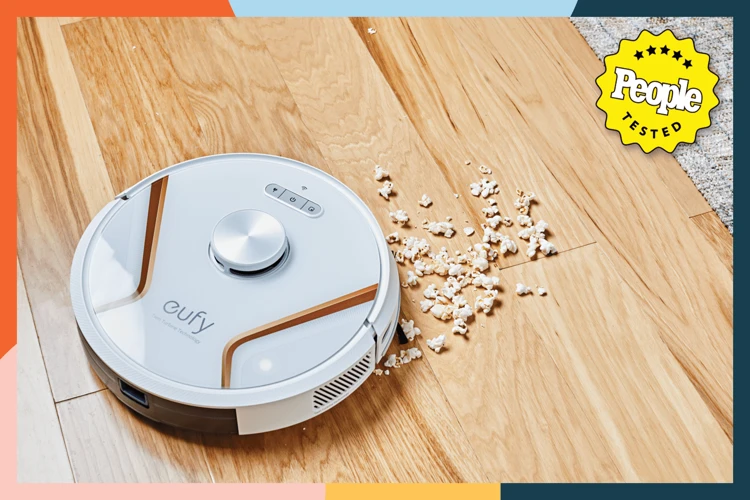
When it comes to smart vacuum cleaners, there are various features that can significantly impact their performance and price. From battery life to suction power, each component plays a crucial role in how well the vacuum cleaner functions. It’s essential to understand these features before investing in a smart vacuum cleaner, as they can often determine the overall value it provides. In this section, we’ll delve deeper into the essential features that every smart vacuum cleaner buyer should know. So, buckle up and get ready to discover what makes a smart vacuum cleaner truly “smart.”
Battery Life
One of the most critical features of any smart vacuum cleaner is its battery life. The battery power of a vacuum cleaner determines how long it can operate before needing a recharge. Additionally, a higher battery life ensures that you can clean larger areas without having to charge the unit multiple times.
There are several factors that can affect battery life, including the age of the battery, the type of cleaning mode used, and the size of the unit itself. For example, stick vacuum cleaners tend to have smaller batteries compared to robot vacuums, and therefore, may not last as long when cleaning larger areas.
When considering the battery life of a smart vacuum cleaner, it is essential to look at the manufacturer’s stated battery life, which can range anywhere from 30 minutes to 2 hours or more. Additionally, it’s important to keep in mind that the actual battery life may vary depending on factors like the suction power of the unit, the type of flooring, and even the presence of obstacles like furniture.
Here are some key considerations related to battery life that you should keep in mind before purchasing a smart vacuum cleaner:
- What is the stated battery life of the vacuum cleaner and how does it fit your cleaning needs?
- Does the battery life vary depending on the cleaning mode you use?
- How does the unit handle different floor types when it comes to battery life?
- Is the battery life enough to clean your entire home or will you need to recharge midway through?
By considering all of these factors, you can make an informed decision about which vacuum cleaner will provide the right balance of battery life, performance, and price for your needs. Remember, just because a vacuum cleaner has a higher price tag does not always mean it has a longer battery life. Doing your research and carefully evaluating your needs is key to finding the right smart vacuum cleaner for your household.
Dustbin Capacity
When it comes to smart vacuum cleaners, the dustbin capacity is an important factor that affects both the price and the performance of the device. This feature determines how much dust, debris, and hair the vacuum cleaner can hold before needing to be emptied.
Different types of smart vacuum cleaners have different dustbin capacities. Robot vacuum cleaners, for example, generally have smaller dustbins because of their compact size. On the other hand, upright and canister vacuum cleaners usually have larger dustbins due to their bigger size and capacity.
It’s worth noting that the dustbin capacity can also vary within the same type of vacuum cleaner. For instance, some models of robot vacuum cleaners may have larger dustbins than others even if they are approximately the same size as their counterparts.
In addition to the size of the dustbin, the material and design of the dustbin can also affect the overall performance of the vacuum cleaner. Vacuums with poorly designed dustbins may have trouble suctioning larger debris or may require more frequent emptying. A well-designed dustbin, however, will not only increase the amount of debris that can be contained but also help keep the vacuum efficient.
Below is a table of the typical dustbin capacities for different types of smart vacuum cleaners:
| Smart Vacuum Cleaner Type | Dustbin Capacity |
|---|---|
| Robot Vacuum Cleaners | 0.3-0.7 liters |
| Stick Vacuum Cleaners | 0.3-0.7 liters |
| Upright Vacuum Cleaners | 1-3 liters |
| Canister Vacuum Cleaners | 1-4.5 liters |
It’s important to consider the dustbin capacity when choosing a smart vacuum cleaner, as a smaller capacity will require more attention and maintenance. However, it is not the only factor that should influence your decision, since a large dustbin capacity isn’t always better. Ultimately, you should choose a smart vacuum cleaner based on a variety of factors to find one that meets your specific needs and budget.
Suction Power
When it comes to smart vacuum cleaners, suction power is one of the most important features that can greatly affect its performance. This feature determines how well a vacuum cleaner can pick up dirt, dust, and debris from various surfaces.
The suction power of a smart vacuum cleaner is measured in air watts (AW). Air watts determine the amount of power a vacuum cleaner uses to move air through its system to create suction. The higher the air watts, the greater suction power a vacuum cleaner has, which makes for better cleaning performance.
However, it’s important to note that suction power alone doesn’t necessarily equate to good cleaning performance. Other factors such as brush roll design and filtration system can also affect a smart vacuum cleaner’s cleaning ability.
Here is a table showing some examples of suction power of popular smart vacuum cleaners on the market today:
| Smart Vacuum Cleaner Model | Suction Power (Air Watts) |
|---|---|
| iRobot Roomba i7+ | 1700 |
| Dyson V11 | 185 AW (in boost mode) |
| Shark IQ Robot Self-Empty XL | 1300 |
| Eufy Robovac 11S | 1300 |
As you can see, there is a range of suction power among these popular smart vacuum cleaner models. The Dyson V11 has the highest suction power in boost mode, which is a testament to Dyson’s reputation for powerful vacuum cleaners.
Suction power is an important factor to consider when purchasing a smart vacuum cleaner, but it’s not the only one. A high suction power can mean better cleaning performance, but other factors such as brush design, filtration system, and battery life should also be taken into account.
Navigation and Mapping
When it comes to smart vacuum cleaners, navigation and mapping capabilities are key determinants of performance. A vacuum cleaner that can navigate through your home effortlessly and map out areas to avoid or clean thoroughly is more likely to provide a comprehensive cleaning experience.
Navigation: Navigation refers to the ability of the vacuum cleaner to move around your home without getting stuck or colliding with obstacles. Navigation systems use various sensors such as infrared sensors, laser sensors, and cliff sensors to detect and avoid obstacles. Some advanced models also use cameras and lidar technology to provide a comprehensive map of your home.
Mapping: Mapping refers to the ability of the vacuum cleaner to create a map of your home and use that map to clean efficiently. A vacuum cleaner with good mapping capabilities can identify areas it has already cleaned and areas that still require cleaning. This ensures that your entire home is cleaned thoroughly without any missed spots.
Here is a table summarizing how navigation and mapping capabilities differ between the different types of smart vacuum cleaners:
| Type of Smart Vacuum Cleaner | Navigation System | Mapping Capabilities |
|---|---|---|
| Robot Vacuum Cleaners | Use various sensors to detect obstacles and navigate around them effectively | Create a visual map of your home and use it to clean systematically |
| Stick Vacuum Cleaners | Easy to maneuver around obstacles due to their lightweight and slim design | No mapping capabilities, but can detect areas that require more thorough cleaning |
| Upright Vacuum Cleaners | Use swivel steering and powerful suction to navigate around obstacles | No mapping capabilities, but some models may have sensors to adjust suction power based on floor type |
| Canister Vacuum Cleaners | Use wheels and a long hose to navigate around obstacles and clean hard-to-reach areas | No mapping capabilities, but some models may have adjustable suction power for different surfaces |
Navigation and mapping play an important role in the performance of smart vacuum cleaners, and different types of vacuum cleaners have varying degrees of navigation and mapping capabilities. It is important to consider the type of vacuum cleaner that best fits your home’s layout and cleaning needs to ensure optimal cleaning performance.
Multi-Surface Cleaning
When it comes to shopping for a smart vacuum cleaner, multi-surface cleaning is a crucial feature to consider. This feature determines the type of floors a vacuum cleaner can clean effectively. Some vacuum cleaners are designed to work well on carpets, while others are ideal for hardwood, linoleum, or tile floors. However, the best smart vacuum cleaners are those that can handle all surfaces equally well.
Here’s a breakdown of how different types of vacuum cleaners perform on various surfaces:
| Carpets | Hardwood Floors | Tile and Linoleum Floors | |
|---|---|---|---|
| Robot Vacuum Cleaners | Good | Good | Good |
| Stick Vacuum Cleaners | Fair | Good | Good |
| Upright Vacuum Cleaners | Good | Fair | Poor |
| Canister Vacuum Cleaners | Good | Good | Good |
As seen from the table above, robot vacuum cleaners are the best option for multi-surface cleaning. They are designed to move around freely and adjust their suction power depending on the type of flooring. Stick vacuum cleaners and canister vacuum cleaners both perform well on all surfaces, but some models are slightly better for certain surfaces than others. Upright vacuum cleaners, on the other hand, are not ideal for tile or linoleum floors.
Additionally, some smart vacuum cleaners come with brushes and rollers specifically designed for pet hair. If you have pets at home, consider looking for models that offer this feature.
Ultimately, the best smart vacuum cleaner for you will depend on your specific needs and preferences. Take your time to research various models, read customer reviews, and compare prices. By doing so, you’ll ensure that you select the right device that fits your cleaning requirements and budget.
Filtration System
One important feature to consider when buying a smart vacuum cleaner is the filtration system. The filtration system plays a crucial role in ensuring that the air inside your home or office is free from dust, allergens, and other harmful particles.
Here are some things to consider when evaluating the filtration system on a smart vacuum cleaner:
- Type of Filter: There are several different types of filters available, including HEPA filters, foam filters, and more. HEPA (High Efficiency Particulate Air) filters are the most effective at trapping small particles like dust, pollen, and pet dander.
- Number of Filters: Some smart vacuums come with multiple filters, including pre-filters and post-filters. Pre-filters can help trap larger particles before they reach the main filter, while post-filters can capture any remaining particles and ensure that only clean air is released.
- Filter Replacement: It’s important to consider how often the filter needs to be replaced and the cost of replacement filters. Some smart vacuums have washable filters, which can save you money in the long run.
- Sealed System: Some high-end smart vacuums feature a sealed filtration system, which ensures that all dirt and particles stay inside the vacuum and don’t escape back into your home.
A good filtration system is important for anyone with allergies or respiratory sensitivities, as it can greatly improve the air quality within your home or office. While a better filtration system may increase the price of a smart vacuum, it can also offer long-term savings by reducing the need for extra air purifiers or allergy medication.
The Relationship Between Price and Performance in Smart Vacuum Cleaners
When it comes to smart vacuum cleaners, consumers are often left wondering whether the high price tag actually correlates with improved performance. Is it worth investing in the most expensive model, or can a budget option still offer an adequate level of cleaning? The relationship between price and performance in smart vacuum cleaners is a complex issue that requires careful examination. Let’s take a closer look at the different price ranges and their corresponding performance levels to help you make an informed decision.
Low Price, Low Performance
When it comes to smart vacuum cleaners, there is often a strong correlation between price and performance. It’s important to keep in mind that a low price may indicate a lower level of performance. Here are some key factors to consider when looking at low-priced smart vacuum cleaners:
- Battery Life: Typically, lower-priced models will have a shorter battery life, which means the vacuum will have to be recharged more frequently during cleaning sessions. This can be frustrating and inconvenient for users.
- Suction Power: Cheaper models may have weaker suction power, which can make it difficult for them to effectively clean carpets or for them to pick up larger debris.
- Dustbin Capacity: Lower-priced models may have smaller dustbin capacities, which means you’ll need to empty the bin more frequently during cleaning sessions. This can be another inconvenience for users.
- Navigation and Mapping: Cheaper models may not have sophisticated navigation and mapping technology, which can result in less efficient cleaning and more collisions with furniture and other obstacles.
- Multi-Surface Cleaning: Cheaper models may not be equipped to effectively clean a variety of surfaces, such as carpets and hard floors.
- Filtration System: Cheaper models may not have advanced filtration systems, which can result in poor air quality and insufficient removal of allergens and dust particles from your home.
While low-priced smart vacuum cleaners may seem tempting, it’s important to weigh the potential drawbacks they may have. They may not perform as effectively as more expensive models and may require more frequent maintenance and manual cleaning. Consider your cleaning needs and budget when selecting a smart vacuum cleaner, but be wary of sacrificing performance for a lower price tag.
Mid-Range Price, Mid-Range Performance
When it comes to mid-range priced smart vacuum cleaners, consumers can expect a balance between performance and affordability. These smart vacuum cleaners typically offer a good mix of features and functionality, making them an ideal choice for those who are looking for quality without breaking the bank.
Here are some features that mid-range priced smart vacuum cleaners commonly offer:
- Decent Suction Power: Smart vacuum cleaners in this price range usually have a decent suction power that allows them to pick up the majority of dirt and debris on floors.
- Basic Navigation and Mapping: While they may not have the most advanced navigation and mapping technology, mid-range smart vacuum cleaners can still get the job done efficiently with basic obstacle avoidance and movement patterns.
- Multi-Surface Cleaning: Most mid-range smart vacuum cleaners will include multi-surface cleaning capabilities, making them suitable for cleaning carpets, hardwood floors, and tile.
- Decent Filtration: Many mid-range priced smart vacuum cleaners have HEPA filtration systems that can capture the smallest dust particles and allergens.
- Moderate Dustbin Capacity: While mid-range smart vacuum cleaners may not have the largest dustbin capacity, they will usually be able to hold enough dirt and debris to clean an average-sized home without needing to be emptied too often.
- Decent Battery Life: Mid-range smart vacuum cleaners typically offer a battery life of around 60 to 90 minutes, which is often enough to clean most homes on a single charge.
While mid-range priced smart vacuum cleaners may not be the most advanced or feature-rich models on the market, they offer consumers a good balance between affordability and functionality. With a decent level of suction power, multi-surface cleaning capabilities, and decent battery life, mid-range smart vacuum cleaners are a great choice for those who want a decent quality smart vacuum cleaner without breaking the bank.
High Price, High Performance
When it comes to high-end smart vacuum cleaners, you can expect top-notch performance and impressive features. Here are some of the key reasons why a higher price tag often translates to high performance:
- Advanced Navigation: High-end smart vacuums often feature advanced navigation systems, utilizing high-tech cameras and sensors to map out your home and navigate around obstacles with ease. This means fewer missed spots and a more thorough clean.
- Powerful Suction: High-end vacuums often feature powerful motors and advanced suction technology that can easily tackle tough dirt and debris on a variety of surfaces. With strong suction, you can expect a more thorough clean with less time and effort.
- Large Dustbin Capacity: Smart vacuums with a higher price tag often come with larger dustbin capacities, allowing you to clean for longer without needing to stop and empty the bin. This is particularly useful for those with larger homes or high-traffic areas that require more frequent cleaning.
- Long Battery Life: If you’re tired of your vacuum running out of battery before completing a full clean, a high-end smart vacuum cleaner may be the way to go. These models often come with longer battery life, sometimes lasting up to 2 hours or more on a single charge.
- Advanced Filtration: High-end smart vacuums may come with advanced filtration systems that can trap even the smallest particles, such as allergens and pet dander. This is especially important for those with allergies or respiratory issues.
Of course, all of these impressive features come with a higher price tag, but for many, the investment is worth it for the convenience and superior cleaning power. If you’re looking for a smart vacuum that can handle the toughest cleaning jobs with ease, a high-end model may be the way to go.
Conclusion
In conclusion, when it comes to smart vacuum cleaners, price is a good indicator of performance, but not always. While some high-priced models may offer exceptional performance, there are also affordable models available that offer comparable performance.
It’s important to consider the features that affect the price and performance of smart vacuum cleaners, such as battery life, dustbin capacity, suction power, navigation and mapping, multi-surface cleaning, and filtration system. Knowing what features are important to you can help you make an informed decision when purchasing a smart vacuum cleaner.
Additionally, it’s important to consider the type of vacuum cleaner you need. Robot vacuum cleaners are great for those who want a hands-off approach to cleaning, while stick vacuum cleaners are ideal for quick cleanups or apartments with limited storage space. Upright vacuum cleaners are great for deep cleaning carpets, while canister vacuum cleaners are perfect for cleaning large areas and hard-to-reach spaces.
Ultimately, the key to finding the right smart vacuum cleaner is to do your research, read reviews, and consider your budget and specific cleaning needs. By doing so, you can find a smart vacuum cleaner that offers the best value for your money and meets your cleaning requirements.
Frequently Asked Questions
What is a smart vacuum cleaner?
A smart vacuum cleaner is a vacuum cleaner that can be connected to a smart device and can be controlled using a mobile application or voice commands.
What are the different types of smart vacuum cleaners?
The different types of smart vacuum cleaners include robot vacuum cleaners, stick vacuum cleaners, upright vacuum cleaners, and canister vacuum cleaners.
What is the difference between suction power and airflow?
Suction power refers to the force with which a vacuum cleaner can pick up dirt, whereas airflow refers to the amount of air that the vacuum cleaner can move.
How does a smart vacuum cleaner navigate?
A smart vacuum cleaner can navigate using various sensors, including infrared sensors, laser sensors, and camera sensors.
Can smart vacuum cleaners clean multiple surfaces?
Yes, many smart vacuum cleaners are designed to clean multiple surfaces, including carpets, hardwood floors, and tiles.
What is a HEPA filter?
A HEPA filter is a type of filter that can capture small particles, such as dust, pollen, and pet dander, making it an ideal filter for people with allergies or asthma.
How often should I replace the filter in my smart vacuum cleaner?
It depends on the manufacturer’s recommendations and how often you use the vacuum cleaner. Generally, filters should be replaced every three to six months.
Can a smart vacuum cleaner be programmed to clean at a specific time?
Yes, many smart vacuum cleaners come with a scheduler feature that allows you to program them to clean at a specific time, even when you’re not at home.
What is the average battery life of a smart vacuum cleaner?
The average battery life of a smart vacuum cleaner is between 60 and 120 minutes, depending on the model and the suction power settings.
Can I use a smart vacuum cleaner to clean my car?
Yes, many smart vacuum cleaners come with additional accessories, such as crevice tools and upholstery brushes, that make them suitable for cleaning cars.

